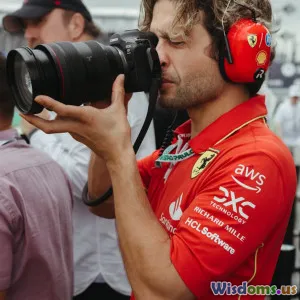
Why High Speed Photography Will Transform Sports Coverage
8 min read Explore how high speed photography revolutionizes sports coverage by capturing split-second moments with unprecedented clarity and impact. (0 Reviews)
Why High Speed Photography Will Transform Sports Coverage
Sports have always thrived on moments—those fleeting instances where skill, speed, and strategy converge to create unforgettable drama. While fans in stadiums witness adrenaline-charged action firsthand, television and digital broadcasts rely heavily on visual storytelling to bring these moments alive. Enter high speed photography: an innovation that doesn’t just capture action but unravels it frame by frame, transforming how sports stories are told and experienced worldwide.
Introduction: The Split-Second Revolution in Sports Imaging
Imagine watching a 100-meter sprint or a BMX stunt unfold in exquisitely detailed slow motion—the flash of a runner's determined expression, the intricate twist of a bicycle mid-air, the precise moment a football leaves a quarterback’s fingers. Traditional photography captures moments in fractions of a second, but high speed photography goes much further, freezing hundreds to thousands of frames per second.
High speed photography’s ability to reveal split-second sports moments not only elevates entertainment but also provides invaluable insights for athletes, coaches, and analysts. As sports coverage increasingly demands immersive and interactive fan experiences, this cutting-edge technology is poised to change the game forever.
The Science Behind High Speed Photography
At its core, high speed photography involves taking many frames per second (often thousands) at incredibly fast shutter speeds. This requires specialized cameras equipped with advanced sensors and rapid processing capabilities. Unlike standard filming which might shoot at 24 to 60 frames per second, high speed cameras operate at hundreds or thousands.
For example, the Phantom Flex4K camera can shoot up to 1,000 frames per second at 4K resolution, allowing broadcasters to capture ultrafine details. The key elements include:
- Fast Shutter Speed: Freezes rapid movement without blur.
- High Frame Rate: Captures every micro-movement by increasing frames per second.
- Efficient Lighting: Necessary to illuminate the scene adequately given the short exposure time.
Such technology does not come without challenges, including massive data output and the need for specialized editing workflows, but the rewards often justify the investment.
Impact on Spectator Experience
Visual Storytelling Elevated to New Heights
Broadcasts enhanced by high speed photography offer fans a deeper connection to the action. Seeing a tennis ball’s spin in mid-air or the milliseconds before a perfect goal allows viewers unprecedented appreciation for athletic skill.
Consider the 2018 FIFA World Cup, where slow-motion replays analyzed with high-speed capture revealed the exact moment a ball grazed a player’s hand, clarifying controversial calls for referees and fans alike. This level of detail improves not just enjoyment but trust in game decisions.
Bringing the Invisible to Light
Many sports moves happen in nano or milliseconds, impossible for human eyes to follow. High speed photography brings these events into slow motion, unveiling biomechanical secrets behind a sprinter’s explosive start or a gymnast’s precise landing.
This fascination drives higher engagement, evident in social media clips where slow-motion highlights go viral, attracting millions. The emotional and educational appeal encourages fans to study and appreciate sports beyond surface excitement.
Transforming Training and Performance Analysis
Enhanced Coaching Techniques
Professional teams increasingly integrate high speed imaging into training regimens. By capturing detailed slow-motion footage of athletes’ form, handlers can pinpoint exact moments of kinetic energy loss or technical errors.
For instance, the U.S. Olympic Swim Team uses high speed cameras to analyze stroke efficiency and improve athletes’ water dynamics. This scientific approach has contributed to breaking world records and enhancing competitive edge.
Injury Prevention and Rehabilitation
High speed footage helps medical staff detect subtle biomechanical issues that could lead to injuries. Analyzing movements frame-by-frame enables tailored interventions, potentially extending athletic careers.
The NBA, for instance, utilizes high speed imaging to study player movements—improving rehab processes and minimizing risk factors for common injuries like ACL tears and tendon strains.
Broadening Storytelling and Marketing Opportunities
Creating Iconic Sports Imagery
Advertisers and sports media thrive on captivating images that capture the intensity and drama of competition. High speed photography provides breathtaking visuals of dramatic crashes, powerful kicks, airborne dunks, and more.
Campaigns by brands like Nike and Red Bull utilize such imagery seamlessly in ads, spotlighting athleticism and innovation while engaging global audiences.
Augmented and Virtual Reality Enhancements
As AR and VR technologies mature, coupling them with high speed photography offers immersive replays and experiences where fans can control playback, zoom in on players’ moves, or virtually step inside game-defining moments.
Interactive sports apps already leverage these innovations, making coverage more dynamic and personalized.
Overcoming Challenges and Looking Forward
Technical and Financial Barriers
Implementing high speed imaging in live sports coverage demands significant investment in hardware, software, and bandwidth. Smaller leagues or broadcasters may face financial hurdles.
However, decreasing costs and increasing accessibility mean even amateur sports broadcasts are approaching these capabilities. Smartphones and consumer-level cameras are beginning to offer high frame rate modes, democratizing slow-motion capture.
Ethical and Sporting Integrity Considerations
Enhanced replay technologies challenge long-established officiating norms. Sports governing bodies must balance technology acceptance with maintaining fairness and flow of play.
The International Cricket Council (ICC) has led by example, integrating high-speed loupes and slow-motion replays for intricate LBW decisions. Ongoing dialogue is essential to harmonize innovation with sport’s spirit.
Conclusion: A New Era for Sports Coverage
High speed photography propels sports coverage into an exhilarating future where every fraction of a second is a story, every sudden move unfolds in magnificent detail, and every viewer gains a front-row seat to the extraordinary.
From unlocking the secrets behind athletic feats to crafting immersive fan experiences, this technology offers far more than visuals—it reshapes how we understand, analyze, and celebrate sport. As adoption widens and capabilities expand, high speed photography isn’t just enhancing sports coverage; it’s revolutionizing the very fabric of sports entertainment.
Embrace the visual rush. Witness the impossible. Sports coverage will never be the same.
Rate the Post
User Reviews
Popular Posts




















